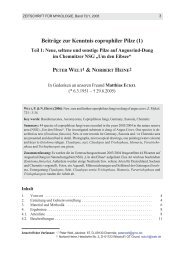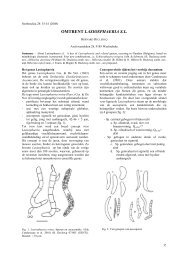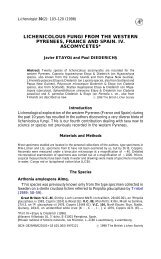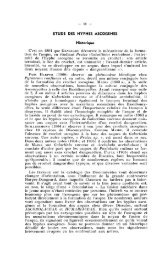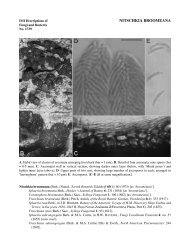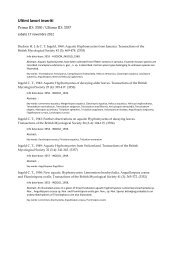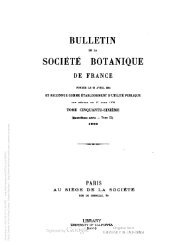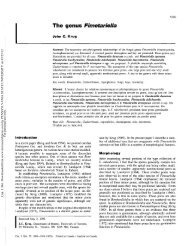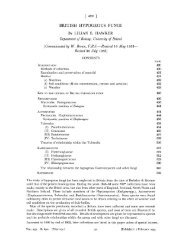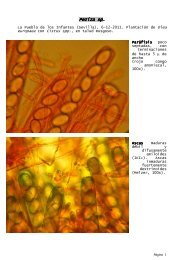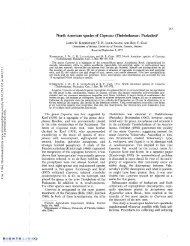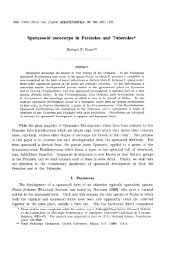Pfister-1973-The-psilopezioid-fungi-IV-Pachyella-0001 - ASCOfrance
Pfister-1973-The-psilopezioid-fungi-IV-Pachyella-0001 - ASCOfrance
Pfister-1973-The-psilopezioid-fungi-IV-Pachyella-0001 - ASCOfrance
You also want an ePaper? Increase the reach of your titles
YUMPU automatically turns print PDFs into web optimized ePapers that Google loves.
2022 CAN. J. BOT, VOL. 51, <strong>1973</strong><br />
EXSICCATI : None.<br />
HOLOTYPE: Auf faulen Holz und der daneben<br />
befindlichen Erde, Alpen bei Partenkirchen, bei<br />
Munchen, IX. 1874. Arnold (S, Herb. Rehm =<br />
CUP 50934).<br />
SPECIMENS EXAMINED : AUSTRIA: On wood and<br />
soil, Vorarlberg, IX.1897, (no collector) (S,<br />
Herb. Rehm). FRANCE: Holotype of Peziza<br />
barlaeana (no substrate), Nice (no date), M.<br />
Barla (PC = CUP 52293). GERMANY: (Substrate<br />
and locality unknown), VII.1887, Dr. Arnold<br />
(S, Herb. Rehm = CUP 50943). RUSSIA: Ad<br />
truncum putridurn, Tsebelda, Furjerosvoje<br />
(Alchariaj, 20.111.1912, G. Woronow (S, Herb.<br />
Rehm = CUP 50942). SWITZERLAND: Kant<br />
Graubunden : Arosa, Seetobelbach, 2 1 .VII. 1961,<br />
E. Rahm (UPS = CUP 50922); (same as above),<br />
30.IX. 196 1, E. Rahm (UPS = CUP 5092 1).<br />
NOTES: Pustularia violaceonigra, published in<br />
1882, is conspecific with Peziza barlaeana Bres.,<br />
published in 1898. It thus provides an older name<br />
for PachyeUa barlaeana. <strong>Pachyella</strong> barlaeana<br />
was selected as type of <strong>Pachyella</strong> by Le Gal<br />
(1 9536). Anatomically this species is nearly<br />
identical in excipular structure with P. clypeata,<br />
P. adwta, and P. megalosperma. <strong>Pachyella</strong><br />
violaceonigra appears to be limited to Europe<br />
whereas P. clypeata is primarily North American.<br />
<strong>Pachyella</strong> clypeata always occurs on rotten wood,<br />
but P. violaceonigra is sometimes found on soil.<br />
<strong>The</strong> other species which it closely resembles, P.<br />
adnata and P. megalosperma, both differ in the<br />
form of their spore markings.<br />
1. <strong>Pachyella</strong> barlaeana (Bres.) Boud. var. steven-<br />
, pro synon. (ut "Stephen-<br />
nsoniana (Ellis in Rehm ex<br />
Rabenh. Kryptog.-Fl. l(3) :<br />
t "Stevensoniana (Ellis j<br />
niana Ellis ex Mussat in<br />
Sacc., Syll. Fung. 15: 126. 1901, pro synon.<br />
(ut Wephensoniana Ellis").<br />
This taxon was synonymized by Seaver (1928)<br />
with Peziza repanda Pers. ex Pers. Examination<br />
of an isotype specimen (Oct. 11, 1878, W. C.<br />
Stevenson 320, CUP-D-447) indicates that his<br />
conclusions were correct.<br />
2. <strong>Pachyella</strong> melaleuca (Bres.) Boud., Hist. Class.<br />
Discom. Eur. p. 51. 1907.<br />
~Discina melaleuca Bres., Fungi Trid. 2:<br />
74. 1898.<br />
deziza melaleuca (Bres.) Seaver, North<br />
American cup-<strong>fungi</strong> (operculates). p. 225.<br />
1928.<br />
= Paradiscina melaleuca (Bres.) Benedix, Die<br />
Kulturpflanze, 17: 255. 1969.<br />
Despite the smooth, non-apiculate spores, this<br />
species is here referred to Discina on the basis of<br />
its apothecial anatomy. This species is also the<br />
type of the genus Paradiscina Benedix.<br />
HOLOTYPE EXAMINED : Sub Pino ~ylvestri,<br />
Gocciador, Italy, 1897, Bresadola (Herb. Rehm,<br />
S = CUP 50937).<br />
3. <strong>Pachyella</strong> rhizinoides (Rabenh.) Boud.. Hist.<br />
Class. Discom. Eur. p. 51. 1907.<br />
= Fleischhakia rhizinoides Rabenh., Hedwigia,<br />
17: 114. 1878.<br />
== Psilopezia rhizinoides (Rabenh.) Rehm,<br />
Rabenhorst Kryptog.-Fl. l(3) : 1 137. 1895.<br />
Neither type nor authentic material has been<br />
located. This taxon has been treated by Hennings<br />
(1903) and Rehm (1895) as a species of Psilo-<br />
pezia. It was synonymized with P. nummularia by



